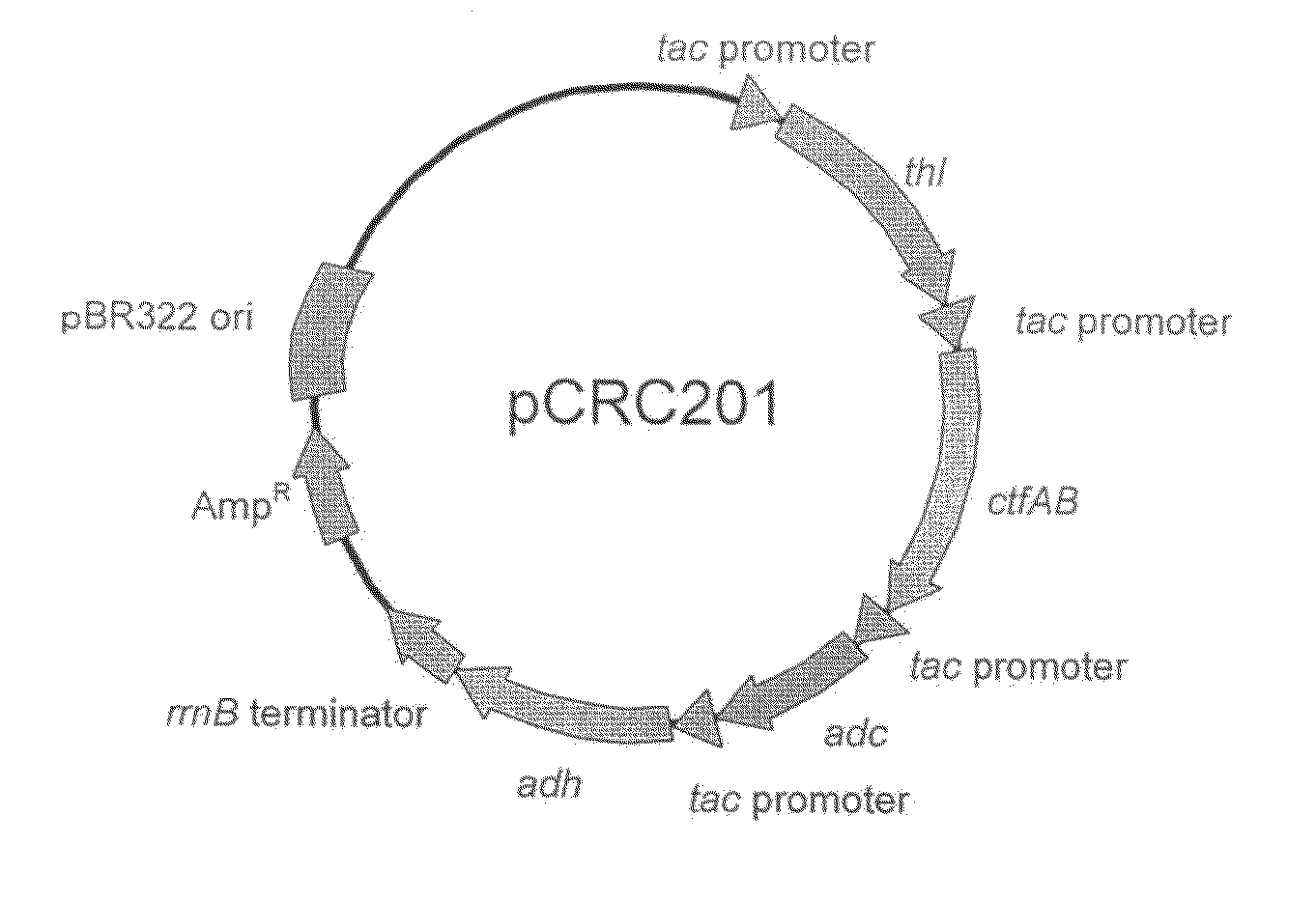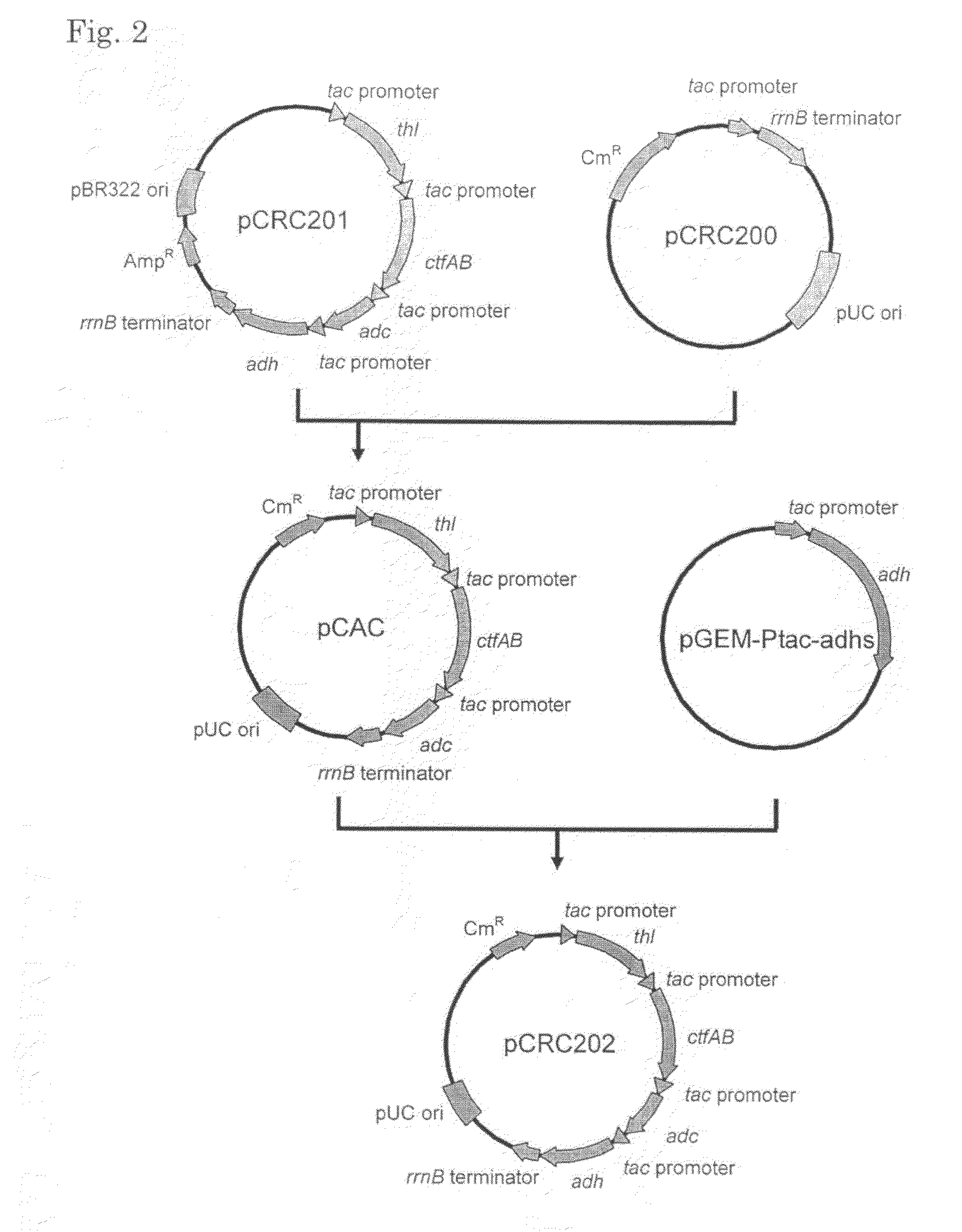Transformant capable of producing isopropanol
a technology of transformant and isopropanol, which is applied in the direction of transferases, lyases, enzymology, etc., can solve the problems of low proliferation rate of bacteria, and low isopropanol production rate, so as to achieve efficient isopropanol production and efficient isopropanol production
- Summary
- Abstract
- Description
- Claims
- Application Information
AI Technical Summary
Benefits of technology
Problems solved by technology
Method used
Image
Examples
example 1
Creation of Escherichia coli JM109 / pCRC201 and Escherichia coli JM109 / pCRC202
(1) Cloning of a Group of Isopropanol-Producing Genes
[0095]The isopropanol biosynthesis pathway (from acetyl CoA to isopropanol) in Clostridium bacteria consists of 4 steps involving 4 enzymes i.e., acetyl-CoA acetyltransferase, acetoacetyl CoA:acetate CoA-transferase, acetoacetate decarboxylase, and isopropanol dehydrogenase. Respective genes which encode these 4 enzymes were amplified by the PCR method as described below.
[0096]Using chromosomal and plasmid DNAs of Clostridium acetobutylicum ATCC 824 (ATCC 824D-5) obtained from American Type Culture Collection (ATCC) as templates, and using primers 1 and 2 (SEQ ID NOs: 1 and 2), primers 3 and 4 (SEQ ID NOs: 3 and 4), and primers 5 and 6 (SEQ ID NOs: 5 and 6), an acetyl-CoA acetyltransferase gene (thl), an acetoacetyl CoA:acetate CoA-transferase gene (ctfAB), and an acetoacetate decarboxylase gene (adc) were respectively amplified by PCR. PCR was performed ...
example 2
Production of Isopropanol by Escherichia coli JM109 / pCRC201 Transformant
[0106]Escherichia coli JM109 / pCRC201 was cultured with shaking in a LB liquid medium (10 g of poly peptone, 5 g of yeast extract and 5 g of NaCl were dissolved in 1 L of distilled water) containing 200 μg / mL of ampicillin at 37° C. for about 16 hours. 500 μL of this culture medium was inoculated in 50 mL of SD8 medium (1 L of aqueous solution containing 7 g of NH4C1, 7.5 g of KH2PO4, 7.5 g of Na2HPO4, 0.85 g of K2SO4, 0.17 g of MgSO47H2O, 10 g of yeast extract, 20 g of glucose and 0.8 mL of trace elements (40 g of FeSO47H2O, 10 g of MnSO4H2O, 28.3 g of Al2(SO4)3, 4 g of CoCl6H2O, 2 g of ZnSO47H2O, 2 g of Na2MoO42H2O, 1 g of CuCl22H2O and 0.5 g of H3BO4 dissolved in 1 L of 5M HCl)) containing 200 μg / mL of ampicillin. Culture was performed with shaking using a 500-mL baffle flask at 37° C. Glucose was added to the culture medium as needed. Isopropanol in the culture medium was analyzed using gas chromatograph GC-1...
example 3
Production of Isopropanol by Escherichia coli JM109 / pCRC202 Transformant
[0110]In the same manner and under the same conditions as in the Example 2 except that Escherichia coli JM109 / pCRC202 was used instead of Escherichia coli JM109 / pCRC201, an experiment of isopropanol production was conducted.
[0111]At 24 hours and 48 hours after the start of culturing Escherichia coli JM109 / pCRC202, the reaction mixture was centrifuged (15,000×g at 4° C. for 10 minutes) and analyzed for isopropanol production by gas chromatography. The results show that isopropanol production at 24 hours was 75 mM and at 48 hours was 162 mM.
[0112]A comparison with the results of JM109 / pCRC201 in Example 2 shows that Escherichia coli JM109 / pCRC202 has higher ability to produce isopropanol.
PUM
| Property | Measurement | Unit |
|---|---|---|
| temperature | aaaaa | aaaaa |
| culture temperature | aaaaa | aaaaa |
| culture temperature | aaaaa | aaaaa |
Abstract
Description
Claims
Application Information
 Login to View More
Login to View More - R&D
- Intellectual Property
- Life Sciences
- Materials
- Tech Scout
- Unparalleled Data Quality
- Higher Quality Content
- 60% Fewer Hallucinations
Browse by: Latest US Patents, China's latest patents, Technical Efficacy Thesaurus, Application Domain, Technology Topic, Popular Technical Reports.
© 2025 PatSnap. All rights reserved.Legal|Privacy policy|Modern Slavery Act Transparency Statement|Sitemap|About US| Contact US: help@patsnap.com



